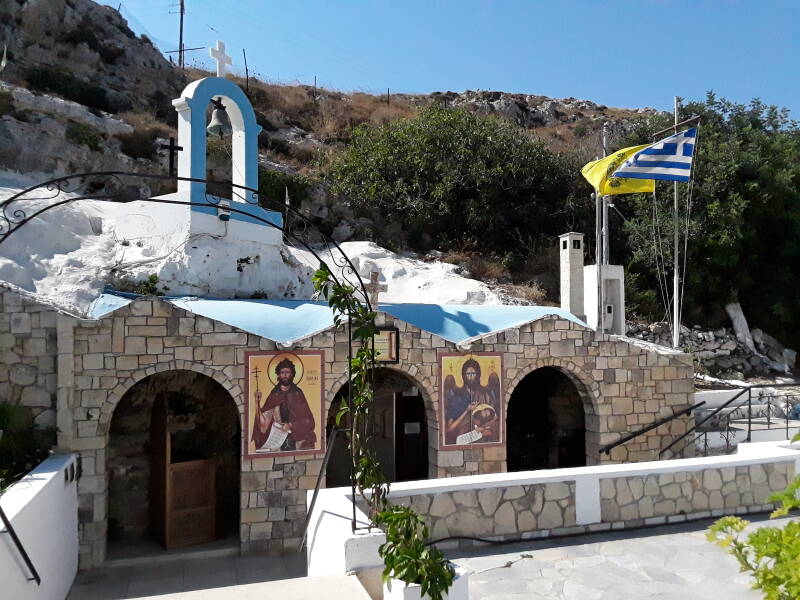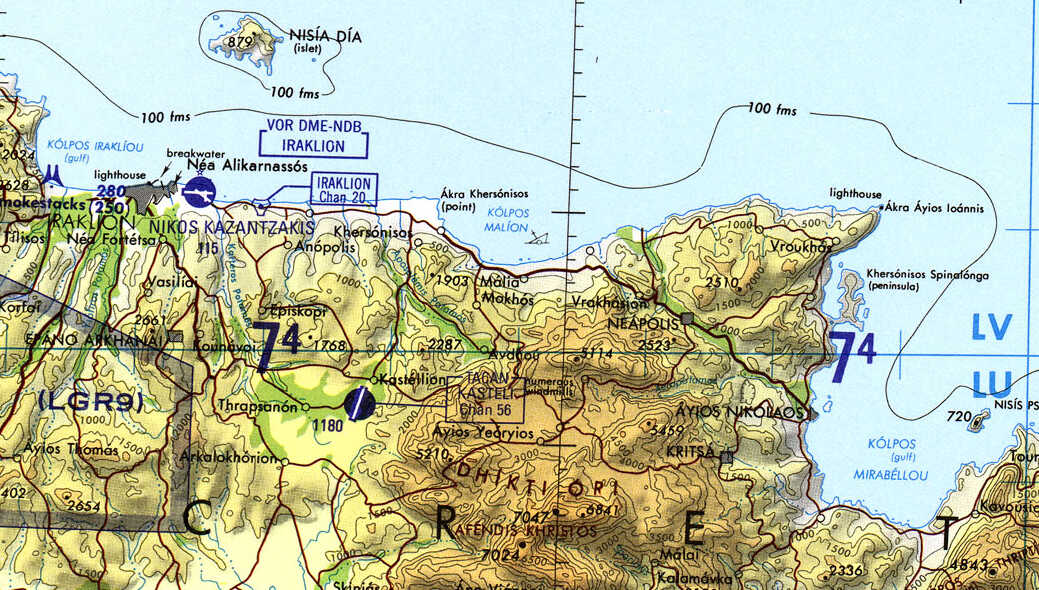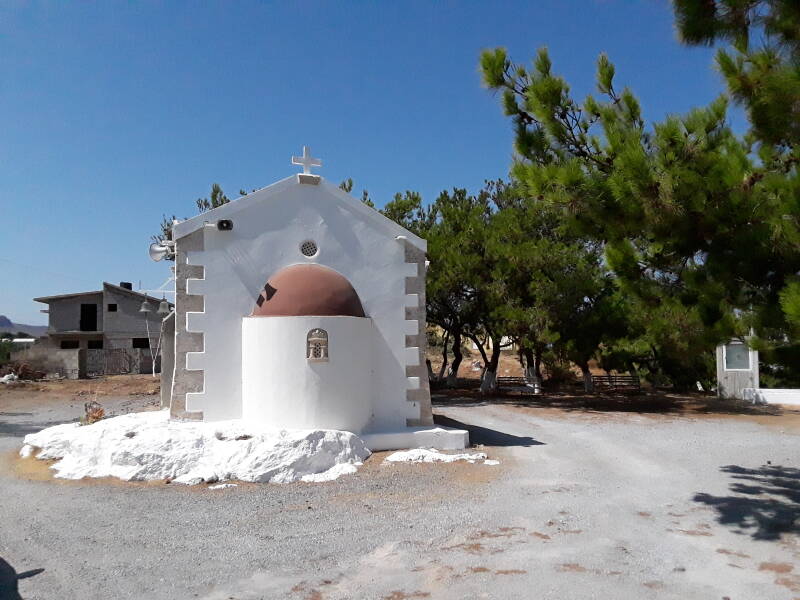
Along the Aegean Coast
East Along the Coast from Heraklion
I was staying in Heraklion and of course
I had been to the Archaeological Museum
and the nearby Minoan palace of
Knossos.
I had rented a car and gone south to
Gortyna
and
Phaistos
on day trips.
Now, on my last day with a car during this first trip to Crete,
I traveled east along the coast from Heraklion,
stopping at several places on my way to
Malia.
I wanted to be on the old road
that runs from Heraklion to Agios Nikolaos,
the Palea EO Irakliou Agiou Nikolaou,
rather than the E 75 expressway.
It was easy to start —
drive through Heraklion to the airport entrance,
then turn right and you're on the old highway.

Church of Saint John and of Saint Nikon the Repentant
The Church of Saint John and of Saint Nikon the Repentant or Εκκλησία Άγιος Ιωάννης και Νίκων ο Μετανοείτε is at the base of the hill as you descend from the plateau on which the airport is built. Willow trees growing up right by the edge of the road have whitewashed trunks. Or maybe it's road-striping paint, the trees are easy to notice. Just past them is a place to pull off and park.

Μετανοώ and μετανοιώνω mean "I repent", while μετανοών and μετανοιωμένος mean "repentant". The name is something like "Saint Nikon the Repenter".
Άγιος Ιωάννης or simply Saint John refers to John the Baptist.
Άγιος Ιωάννης Θεολόγος or John the Theologian refers to Jesus's disciple, the author of the Gospel of John, the author of the Letters from John in the New Testament, and the author of the Αποκάλυψη or Revelation. It's now generally thought that those aren't all references to one person. More likely, three or four people, or two or three individuals plus a group for the Gospel of John authorship.
Icons on the exterior show Nikon on the left and John on the right.


Much of the interior is roughly carved into the stone hillside.

Modern frescoes depict saints from Crete.

It is laid out with two parallel naves, with two altar areas. One nave dedicated to John, one to Nikon.

The church and the beach across the road are close to the east end of the single 8,000-foot runway at HER, Heraklion's Nikos Kazantzakis Airport. The wind usually favors operations toward the west. The airport is on the east edge of the city, so departures usually climb and turn north over the harbor. The airport has lots of flights, it's the second busiest in Greece. It handled 55,680 flights and just over 8 million passengers in 2018.

Looking east down the beach, that's the direction I was headed. There were two stops before reaching that high point in the distance.

Here's the terrain. My route was along the north coast.

Tactical Pilotage Chart G-3C from the Perry Castañeda Library Map Collection at the University of Texas.
The Sanctuary of Zeus Thenatas
The name of the next site is a little confusing. It's the Sanctuary of Zeus Thenatas. That was an epithet of Zeus unique to Crete, referring to his navel or umbilical cord which was lost here after his birth nearby.
It's easy to mis-read that as "Zeus Thanatos", the "Death Zeus" or whatever. But no, that last word isn't "death" or θάνατος. There it is on the sign, θενάτα or thenata.
The national yellow-on-brown signs marking archaeological sites in this area get overwhelmed with all the signs for hotels, resorts, bars, cafes, and so on.

The small hill is Paleochora Hill, or "Old-Town Hill". There was a fortified village on the hill during the period of 1205–1669 when the city-state of Venice ruled Crete. It was built on remains of dwellings going back to early Minoan times, 2000 BCE or earlier.
The earliest Minoan settlement may have been named Thenai. By late Minoan times, it was called Amnissos.
Amnissos was included in a list of stops of an ambassadorial trip made around 1380 BCE by representatives of Amenophis III of Egypt. It was also mentioned as 𐀀𐀖𐀛𐀰 or A-MI-NI-SO on Linear B tablets that recorded Mycenaean Greek, mostly on tablets found at nearby Knossos.
𐀀𐀖𐀛𐀰 and "Amnissos" played a key role when Michael Ventris was figuring out how to read Linear B. He had constructed tables of possible phonetic values for the Linear B signs. He made an educated guess that 𐀀𐀖𐀛𐀰 referred to the port of Knossos, named Amnissos in various Archaic and Classical works. That was correct, and it led to figuring out the rest of the Linear B syllabary.

Linear B tablet bearing the place name Amnissos, in the Heraklion Archaeological Museum.
Homer referred to Amnissos in the Odyssey (19.188-89), saying that its harbor was "difficult". Whether it was a good harbor or not, it seems to have been the harbor for Knossos.

The sea level is about three meters higher than it was in Minoan times. Remains of the harbor are underwater.
There's a tiny islet just offshore. Beyond that in the haze, about seven nautical miles away, is Dia, an island about five by three kilometers in size. Myth says that Theseus and Ariadne fled to Dia after he killed her half-brother the half-bull Minotaur and they escaped the Labyrinth. Then they continued to Naxos, where he notoriously ditched her. Or at least that's Hesiod's version of the story. According to Homer, Artemis killed her on Dia.

The Sanctuary of Zeus Thenatas was built here in the 7th century BCE, on top of ruins of a Minoan cult center. There are remains of cult activity here going back at least to the 10th century BCE. Sacrifices were burned on an open-air round stone altar.
The site has yielded votive objects from the Archaic Period (ca 800–480 BCE) and faience objects imported from Egypt.

The sanctuary was rebuilt at the end of the 2nd century BCE, and the cult of Zeus Thenatas continued to operate here at least into the 2nd century CE.

The House of the Lilies
A Minoan villa called the House of the Lilies is on the other side of that hill. Archaeologists gave it that name because of the murals, some of which you can see in the Heraklion Archaeological Museum.

It's enclosed by a fence. A gate on the south was tied shut with a rope. There were no signs, so I chose to interpret the fence and gate as being intended to keep pets and livestock out.
The frescoes of lilies, irises, and papyrus were in the nearest room in the below picture.

The mansion was built by some important figure during the 16th century BCE. The murals probably depicted a sacred garden.
The villa was built on a grand scale, but it lacked storage and service areas. It may have been the beach house of the rulers of Knossos.

The villa, along with the Minoan palaces at Knossos and Phaistos, were heavily damaged by fire in the 15th century BCE.
Dating theThera Eruption
It used to be thought that the catastrophic explosion of Thera or Θήρα, a volcanic island some 120 kilometers to the north, ended the Minoan civilization with a combination of a devastating tsunami and a suffocating blanket of ash.
However, Thera blew up around 1600–1630 BCE and the Minoan sites were still occupied for another 150 to 200 years. No more than 5 mm of ash was deposited anywhere on Crete. And, the destruction here and at Knossos, Phaistos, and Malia happened at the same time that the Mycenaean Greeks invaded in 1450 1400 BCE and replaced the Minoan rule.
Paper in Nature Overview in NatureThe paper "Severe multi-year drought consistent with Hittite collapse around 1198–1196 BC", published in Nature in February 2023, reported on a study of tree rings at Gordion in central Anatolia. There was a shift to drier, cooler climate conditions around 1200 BCE, but it was very gradual. The new study found "an unusually severe continuous dry period from around 1198 to 1196 (3±) BC". As they describe, argriculture and food storage in that region and era could withstand a year of drought. But two consecutive years would lead to a society's collapse.
Visiting HatuşaşTheir study was at Gordion and Hatuşaş, which had been the capital of the Hittite Empire for centuries. They speculate that this drought could have caused the collapse of the Hittite Empire, and possibly been at least part of the general societal collapse around the eastern Mediterranean.

This villa was rebuilt and re-occupied until it was abandoned in the 12th century BCE.

WWII Crete
The villa was rediscovered and then excavated in 1932. Unfortunately, the site was heavily damaged by occupying German troops during World War II. Luckily the frescoes had already been removed and were stored safely through the war.

Kato Gouves
I continued east on the coast road through a series of beach towns.
Gouves is about twenty kilometers east of Heraklion and a couple of kilometers inland. Kato Gouves is the associated beach resort area.
I noticed the Ekklisia Profitis Ilias or Εκκλησία Προφήτης Ηλίας, the Church of the Prophet Ilias, called Elijah in English translations.

This visit was in September 2021. Greece was re-opening after being mostly shut down by the COVID-19 pandemic. This small church was still configured for outdoor services under an attached tent.

They could roll up the side panels for excellent ventilation during a service.

Here's a large icon of their patron saint. Ilias is in his cave in the mountains with a raven bringing him food. Churches dedicated to him are usually on isolated peaks. But not all of them, this one is in a beachfront community.

I was part-way to the Minoan palace complex at Malia. See the next page to continue your virtual trip along the coast.
Or, Continue Through Greece:
Where next?